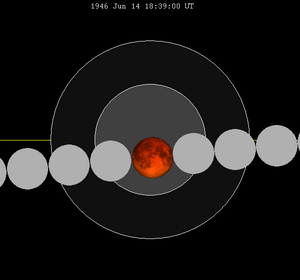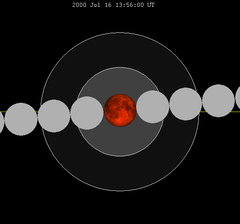| Total eclipse | |||||||||||||||||
 The Moon's hourly motion shown right to left The Moon's hourly motion shown right to left | |||||||||||||||||
| Date | June 14, 1946 | ||||||||||||||||
|---|---|---|---|---|---|---|---|---|---|---|---|---|---|---|---|---|---|
| Gamma | −0.2324 | ||||||||||||||||
| Magnitude | 1.3983 | ||||||||||||||||
| Saros cycle | 129 (34 of 71) | ||||||||||||||||
| Totality | 91 minutes, 9 seconds | ||||||||||||||||
| Partiality | 229 minutes, 3 seconds | ||||||||||||||||
| Penumbral | 369 minutes, 12 seconds | ||||||||||||||||
| |||||||||||||||||
| ← December 1945December 1946 → | |||||||||||||||||
A total lunar eclipse occurred at the Moon’s descending node of orbit on Friday, June 14, 1946, with an umbral magnitude of 1.3983. A lunar eclipse occurs when the Moon moves into the Earth's shadow, causing the Moon to be darkened. A total lunar eclipse occurs when the Moon's near side entirely passes into the Earth's umbral shadow. Unlike a solar eclipse, which can only be viewed from a relatively small area of the world, a lunar eclipse may be viewed from anywhere on the night side of Earth. A total lunar eclipse can last up to nearly two hours, while a total solar eclipse lasts only a few minutes at any given place, because the Moon's shadow is smaller. Occurring about 1.8 days after apogee (on June 12, 1946, at 22:40 UTC), the Moon's apparent diameter was smaller.
This lunar eclipse was the third of an almost tetrad, with the others being on June 25, 1945 (partial); December 19, 1945 (total); and December 8, 1946 (total).
The northern tip of the Moon passed through the center of the Earth's shadow. This was the first central lunar eclipse of Lunar Saros 129.
Visibility
The eclipse was completely visible over east Africa, central, south, and southeast Asia, western Australia, and Antarctica, seen rising over much of Africa, eastern South America, Europe, and west Asia and setting over northeast Asia and eastern Australia.
 
|
Eclipse details
Shown below is a table displaying details about this particular solar eclipse. It describes various parameters pertaining to this eclipse.
| Parameter | Value |
|---|---|
| Penumbral Magnitude | 2.46538 |
| Umbral Magnitude | 1.39833 |
| Gamma | −0.23239 |
| Sun Right Ascension | 05h29m50.7s |
| Sun Declination | +23°15'55.5" |
| Sun Semi-Diameter | 15'44.7" |
| Sun Equatorial Horizontal Parallax | 08.7" |
| Moon Right Ascension | 17h29m42.4s |
| Moon Declination | -23°28'21.8" |
| Moon Semi-Diameter | 14'45.4" |
| Moon Equatorial Horizontal Parallax | 0°54'09.4" |
| ΔT | 27.6 s |
Eclipse season
See also: Eclipse cycleThis eclipse is part of an eclipse season, a period, roughly every six months, when eclipses occur. Only two (or occasionally three) eclipse seasons occur each year, and each season lasts about 35 days and repeats just short of six months (173 days) later; thus two full eclipse seasons always occur each year. Either two or three eclipses happen each eclipse season. In the sequence below, each eclipse is separated by a fortnight. The first and last eclipse in this sequence is separated by one synodic month.
| May 30 Ascending node (new moon) |
June 14 Descending node (full moon) |
June 29 Ascending node (new moon) |
|---|---|---|
 |
 |

|
| Partial solar eclipse Solar Saros 117 |
Total lunar eclipse Lunar Saros 129 |
Partial solar eclipse Solar Saros 155 |
Related eclipses
Eclipses in 1946
- A partial solar eclipse on January 3.
- A partial solar eclipse on May 30.
- A total lunar eclipse on June 14.
- A partial solar eclipse on June 29.
- A partial solar eclipse on November 23.
- A total lunar eclipse on December 8.
Metonic
- Preceded by: Lunar eclipse of August 26, 1942
- Followed by: Lunar eclipse of April 2, 1950
Tzolkinex
- Preceded by: Lunar eclipse of May 3, 1939
- Followed by: Lunar eclipse of July 26, 1953
Half-Saros
- Preceded by: Solar eclipse of June 8, 1937
- Followed by: Solar eclipse of June 20, 1955
Tritos
- Preceded by: Lunar eclipse of July 16, 1935
- Followed by: Lunar eclipse of May 13, 1957
Lunar Saros 129
- Preceded by: Lunar eclipse of June 3, 1928
- Followed by: Lunar eclipse of June 25, 1964
Inex
- Preceded by: Lunar eclipse of July 4, 1917
- Followed by: Lunar eclipse of May 25, 1975
Triad
- Preceded by: Lunar eclipse of August 13, 1859
- Followed by: Lunar eclipse of April 14, 2033
Lunar eclipses of 1944–1947
| Descending node | Ascending node | |||||
|---|---|---|---|---|---|---|
| Saros | Date viewing |
Type chart |
Saros | Date viewing |
Type chart | |
| 109 | 1944 Jul 06
|
Penumbral
|
114 | 1944 Dec 29
|
Penumbral
| |
| 119 | 1945 Jun 25
|
Partial
|
124 | 1945 Dec 19
|
Total
| |
| 129 | 1946 Jun 14
|
Total
|
134 | 1946 Dec 08
|
Total
| |
| 139 | 1947 Jun 03
|
Partial
|
144 | 1947 Nov 28
|
Penumbral
| |
Saros 129
Lunar saros series 129, repeating every 18 years and 11 days, containing 71 events, has 11 total lunar eclipses. The first total lunar eclipse of this series was on May 24, 1910, and last will be on September 8, 2090. The longest occurrence of this series was on July 16, 2000 when totality lasted 106 minutes and 24.6 seconds.
| Greatest | First | |||
|---|---|---|---|---|
 The greatest eclipse of the series occurred on 2000 Jul 16, lasting 106 minutes. |
Penumbral | Partial | Total | Central |
| 1351 Jun 10 | 1513 Sep 15 | 1910 May 24 | 1946 Jun 14 | |
| Last | ||||
| Central | Total | Partial | Penumbral | |
| 2036 Aug 7 | 2090 Sep 8 | 2469 Apr 26 | 2613 Jul 24 | |
| 1910 May 24 | 1928 Jun 3 | 1946 Jun 14 | |||

|

|

|

|

|

|
| 1964 Jun 25 | 1982 Jul 6 | 2000 Jul 16 | |||

|

|

|

|

|

|
| 2018 Jul 27 | 2036 Aug 7 | 2054 Aug 18 | |||

|

|

|

|

|

|
| 2072 Aug 28 | 2090 Sep 8 | ||||

|

|

|

| ||
It last occurred on June 3, 1928 and will next occur on June 25, 1964.
This is the 34th member of Lunar Saros 129. The previous event was the June 1928 lunar eclipse. The next event is the June 1964 lunar eclipse. Lunar Saros 129 contains 11 total lunar eclipses between 1910 and 2090. Solar Saros 136 interleaves with this lunar saros with an event occurring every 9 years 5 days alternating between each saros series.
Half-Saros cycle
A lunar eclipse will be preceded and followed by solar eclipses by 9 years and 5.5 days (a half saros). This lunar eclipse is related to two total solar eclipses of Solar Saros 136.
| June 8, 1937 | June 20, 1955 |
|---|---|

|

|
See also
Notes
- "June 14–15, 1946 Total Lunar Eclipse (Blood Moon)". timeanddate. Retrieved 20 December 2024.
- "Moon Distances for London, United Kingdom, England". timeanddate. Retrieved 20 December 2024.
- "Total Lunar Eclipse of 1946 Jun 14" (PDF). NASA. Retrieved 20 December 2024.
- "Total Lunar Eclipse of 1946 Jun 14". EclipseWise.com. Retrieved 20 December 2024.
- Mathematical Astronomy Morsels, Jean Meeus, p.110, Chapter 18, The half-saros
External links
- 1946 Jun 14 chart Eclipse Predictions by Fred Espenak, NASA/GSFC
This lunar eclipse-related article is a stub. You can help Misplaced Pages by expanding it. |


